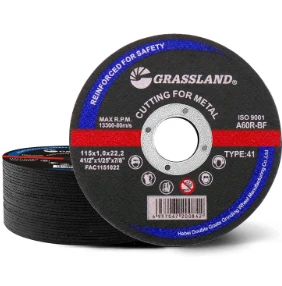Understanding 4% Grinding Wheels for Metal A Comprehensive Guide
Grinding wheels play a crucial role in metalworking, serving as essential tools for shaping, cutting, and finishing various metallic surfaces. Among the various types of grinding wheels available, the 4% grinding wheel stands out for its unique properties and applications. This article explores what makes these wheels significant in metal fabrication, their composition, uses, advantages, and maintenance tips.
Composition of 4% Grinding Wheels
The term 4% grinding wheel typically refers to the bond and abrasive composition that constitutes 4% of the wheel's material. These wheels are primarily made from abrasive particles, such as aluminum oxide, silicon carbide, or diamond, combined with a bonding material, which can be resin, vitrified clay, or rubber. The 4% indicates that 4% of the wheel consists of specific abrasive materials engineered to provide a specific performance level during metalworking tasks. This precise mixture is vital, as it dictates the wheel's grinding efficiency, durability, and suitability for different applications.
Applications
4% grinding wheels are widely used in various metalworking applications, including
1. Surface Grinding They are perfect for achieving a smooth finish on flat surfaces, removing excess materials, and correcting imperfections. The defining characteristics of a 4% grinding wheel allow it to adhere closely to the metal surface, ensuring uniform grinding.
2. Edge Grinding For metal parts with intricate edges, these wheels provide the precision required to shape, sharpen, and deburr metal edges effectively.
3. Cutting Operations In addition to grinding, some 4% wheels can also serve as cutting tools, capable of slicing through metal stock with ease. This is particularly useful in industries where fabrication and assembly require quick alterations or adjustments.
4. Finishing Applications The fine abrasive qualities of the 4% wheels make them ideal for finishing tasks, where smoothness and aesthetics are critical. They can help achieve a mirror-like polish on metals, enhancing their visual appeal while simultaneously protecting against corrosion.
Advantages of 4% Grinding Wheels
- Versatility One of the most significant advantages of 4% grinding wheels is their versatility across different metal types and applications. Whether working with steel, aluminum, or more exotic alloys, these wheels can adapt to meet specific grinding requirements.
4 grinding wheel for metal

- Enhanced Efficiency The precise formulation of abrasives ensures that 4% grinding wheels maintain their sharpness longer, reducing the frequency of wheel changes and downtime on the shop floor. This efficiency translates into cost savings and higher productivity.
- Improved Finish Quality The tailored composition of these grinding wheels enables operators to achieve better finishes compared to standard wheels. This can be particularly beneficial in industries where product aesthetics are paramount.
- Operator Safety Quality manufacturing standards often mean that 4% grinding wheels are less prone to breaking or chipping during operation. This not only protects the workpiece but also enhances safety for operators.
Maintenance and Care
To maximize the lifespan and performance of 4% grinding wheels, proper maintenance is crucial. Here are some tips
1. Regular Inspection Check the wheels for signs of wear, cracks, or chips before each use. Replace any damaged wheels to prevent accidents.
2. Proper Storage Store grinding wheels in a cool, dry place to avoid moisture absorption that can weaken them.
3. Correct Usage Always match the wheel type to the appropriate metal and adhere to the manufacturer's guidelines regarding maximum RPM limits to ensure safe operation.
4. Cleaning Keep the grinding area clean and remove metal shavings and dust regularly. Use a wire brush or appropriate tools to clean the grinding wheel between uses.
Conclusion
In summary, 4% grinding wheels are an integral part of metalworking processes due to their unique composition, versatility, and efficiency. By understanding their applications, advantages, and proper maintenance techniques, metalworkers can optimize their use for achieving superior results. As technology continues to evolve, the development of grinding wheels will likely advance, further enhancing their performance and capabilities in the metalworking industry.
Post time:Jan - 02 - 2025

















